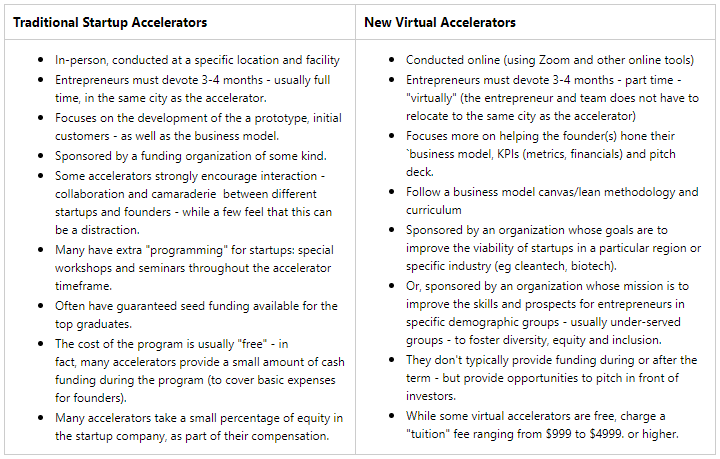
Virtual Accelerators are one of the most prominent startup trends of the past 5 years — booming in the post-pandemic Zoom era.
Hundreds (even thousands) of organizations around the world are now offering a variety of startup-acceleration programs. If you’re an entrepreneur or thinking about launching a startup, you might be tempted to take part in one of these programs. Before you take the leap, know what your getting into — and getting out of — the experience.
Part 1: The Basics. What you need to know. Virtual Accelerators: What are they? Are they for you?
Virtually Different
First: Understand that Virtual Accelerators are different than their predecessors, Startup Accelerators. Both offer a specific cadence of lessons and exercises for entrepreneurs — becoming intensive bootcamps that help founders become better entrepreneurs. Both help entrepreneurs prepare their startup ventures for a rapid growth trajectory, and help them attract angel or venture funding.
Being completely online and remote, virtual accelerators are easier for organizations to launch, and for founders to participate. They are a relatively recent phenomenon, evolving and diverging from traditional accelerators.
Differences between Startup Accelerators & Virtual Accelerators:

Founders, if you are considering taking part in a virtual accelerator, here are the 4 things you need to know before you start:
1 — Virtual Accelerators are about growth and scaling — not about starting and running.
Most virtual accelerators are not about teaching you to “operate” a business day-to-day, nor do they focus on actually starting (establishing) your new business. While both are essential entrepreneurship skills, virtual accelerators are mainly about preparing your company for rapid growth — hence the “acceleration” part.
Virtual accelerators are about what your business will be and not about where your business is right now. This means a focus on scaling — proportional, and often disproportional, growth. Most likely this means preparing your company to attract, and be attractive for, investors.
2 — It’s Hard Work, and you WILL have to change.
The last thing startup entrepreneurs need is more hard work, and almost no one like change — even the most enlightened innovators. But no entrepreneurial idea or product is perfect out-of-the-gate. There’s a 99% chance you will have to change aspects of your business, your product and target market.
You will probably have to change some core assumptions about your product, or your market or about your company’s goals. It’s inevitable. For a short time, it won’t be much fun. It will be frustrating, and even depressing. And it certainly won’t feel good. You may even think that you’re being forced to dismantle your cool idea and start over.
Take a deep breath.
Understand that acceleration isn’t about executing your “dream”, or merely doing things that make you happy. It’s about taking a hard, objective, look at your core assumptions, and a realistic deep dive into your product-market fit, into your market size, customers and business.
Often you’re too close to the “idea”, the product or the company — and are confusing inertia with momentum, and want to stay on your current course. Virtual accelerators are about getting you on the right path — sometimes a different path — so your company can grow, thrive and succeed.
3 — The training can seem academic and impractical.
Most virtual accelerators use some form of the Lean Startup Methodology and Business Model Canvas as the basis for the training. At first, some of the exercises — particularly those around defining your markets and business model — will seem like college homework assignments. Many “ready-fire-aim” entrepreneurs get impatient or frustrated with research, planning, and creating models.
But stick with it.
The work and outcomes are incredibly valuable, and essential for transforming your startup’s prospects for success — particularly in the eyes of customers and investors.
Think of the experience much like Mr. Myagi training young Daniel-san in “The Karate Kid” — forcing him to do a series of seemingly pointless and futile chores and exercises, until, it becomes [quite apparent] that his training has been .. practical and powerful, all along.
At the end of the virtual accelerator, if you follow the curriculum and complete the assignments, it will make you a better entrepreneur, and make your startup product (and story) more powerful and compelling.
4 — Coaches and Mentors: The real advantage.
At the heart of all accelerators is the cadre of coaches and mentors — seasoned experts and entrepreneurs well experienced in building companies. They are usually former entrepreneurs, and/or experts in specific functional areas of business, finance and marketing.
But use them wisely, and properly:
- Ask them for their background and bio: A lot of coaches and mentors don’t really have direct startup experience — but they do excel at certain skills: e.g finance, law, technology. Know how to leverage (and when to filter) their advice.
- Don’t be too quick to disregard feedback that you don’t like. Often their feedback will be terse, abrupt, and un-sugarcoated. Your response will be “ah — they just don’t get it”. But 99% of the time they do get it — even more than you do! And, just because they disagree with you, doesn’t mean they are wrong.
- When working with multiple coaches, keep in mind that coaches often are vying to look smart in front of each other. But this can be a good thing. It’s valuable when they all agree, and sometimes even more valuable when they disagree.
Ultimately, coaches and mentors are the hidden and unsung value of the virtual accelerator experience. They are smart, have deep experience and a broad perspective, and they really want to help — so listen to them. Try to use them as much as possible.
Virtual but Vital
Going through the rigors of a virtual accelerator program is about getting you ready, as entrepreneur. and getting your startup on the right track.
It’s akin to setting a rocket-ship upright on the launchpad, pointed at the moon. Getting it set up right, and pointed in the right direction is essential — but it’s only the beginning. You need fuel, a crew, and you need to know how to pilot the ship to the grand destination. But if you’re not ready and pointed in the right direction, you’ll never get off the launchpad — and might crash and burn.
Virtual Accelerators can be the vital first step.
Next up –
Part 2 — The Fog of War — what happens during the typical program, when things get intense
CJ Cornell is a 6x founder/entrepreneur with 3 exits; a university entrepreneurship professor, the author of 3 books, and published research papers on entrepreneurship and innovation. Over the past 20 years, he’s also been a veteran mentor and coach at 3 startup accelerators, 2 incubators, and at 9 virtual accelerators.
He is the author of the bestselling “The Age of Metapreneurship — A Journey into the Future of Entrepreneurship.”

And the upcoming “The Startup Brain Trust — A Guidebook for Startups, Entrepreneurs, and the Mentors that Help them Become Great.”
Follow him @cjcornell or visit: www.cjcornell.com
Image Credit: Northrop Grumman
